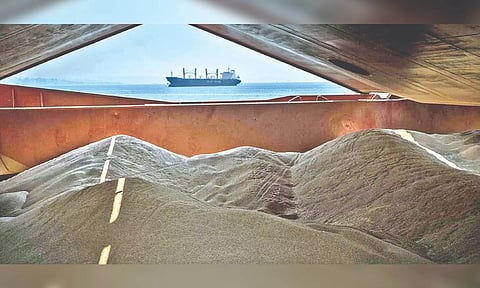

By PETER SINGER
KYIV: After Russia’s full-scale invasion in February 2022, ships used to export grain from Ukraine’s Black Sea ports stopped traveling there because they were liable to be attacked by Russian forces, which suspected them of carrying military supplies. That caused grain prices to soar to record levels and sparked fears of famine in countries in the Middle East and Africa that had previously imported Ukrainian grain, especially wheat.
Eventually, in July 2022, Russia agreed to give ships traveling to and from Ukraine safe passage, on the condition that Russian officials could inspect them. During the 11 months that the Black Sea Grain Initiative was in effect, Ukraine exported 33 million tons of grain, and world food prices declined by approximately 20%. According to the United Nations, 57% of the exported foodstuffs went to developing countries. But now Russia has withdrawn from the arrangement.
When Russia announced that it would let the agreement expire on July 17, the price of grain rose by 8%. UN Secretary-General António Guterres warned that millions of people would now be facing hunger, and US Secretary of State Antony Blinken said that “Russia is responsible for denying food to people who are desperately needy around the world.” In Kenya, the government described Russia’s conduct as a “stab in the back” for people in drought-stricken countries (a group that currently includes Kenya).
In addition to ending the agreement and declaring that it will regard any cargo ships heading for Ukrainian ports as potentially carrying military goods, Russia has targeted Ukrainian ports on the Danube River, which could offer an alternative export route, and has also attacked grain storage facilities in Odesa, destroying an estimated 60,000 tons of grain. At a recent Russia-Africa Summit in St. Petersburg, President Vladimir Putin attempted to show concern about possible grain shortages in Africa by promising 25,000-50,000 tons of Russian grain to six African countries (in four of which Russia’s Wagner Group mercenaries operate).
Kenya was not among them. In any case, the total quantity of grain pledged is less than 1% of the grain shipped by Ukraine while the agreement was in effect. There can be no justification or excuse for Russia, in furtherance of its war of aggression against Ukraine, to target that country’s grain exports, knowing that this will drive up grain prices and increase hunger among people in countries far from the conflict. Nevertheless, comments from leaders like Guterres and Blinken risk creating the false impression that the world relies on Ukraine to produce enough grain to feed its people.
Each year, the world produces about 750 million tons of wheat and 1.1 billion tons of maize. Of this, 20% of the wheat (150 million tons) and 61% of the maize (671 million tons) is fed to animals confined in what the industry calls “Concentrated Animal Feeding Operations” or CAFOs. (That’s in addition to 77% of the world’s soybean crop.)
When we feed animals crops that we could eat, we end up with fewer calories and less protein than the crops themselves contain. That’s because the animals use the majority of the nutritional value of their food to keep their bodies warm and functioning, and to develop bones and other body parts that we do not eat. One study carried out in the United States showed that grains and soy fed to beef cattle return less than 3% of the calories and protein that the crops contain, less than 10% when fed to pigs, and still only 21% when fed to chickens, the most efficient converters.
Putting all these figures together, and assuming that the average nutritional return across all the animals in CAFOs is 20% (although it is almost certainly less), we can conclude that feeding 150 million tons of wheat and 671 million tons of maize to animals is effectively wasting 120 million tons of wheat and 537 million tons of maize. In comparison, the 33 million tons of grain that Ukraine exported when the Black Sea agreement with Russia was in operation is a relatively modest quantity.
Blinken is right to say that Russia is responsible for denying food to desperately needy people around the world, but let’s not pretend that other countries are powerless to prevent the food shortages brought about by Russia’s willingness to attack ships carrying Ukrainian wheat. The US alone could easily offset the loss of Ukrainian exports by reducing the number of animals in CAFOs and exporting the resulting grain surplus.
The task would be easier still if other countries that produce most of their meat from CAFOs did the same. By taxing meat, governments would free up enough grain to feed the “desperately needy around the world.” In the process, they would also reduce local air and water pollution, cut greenhouse-gas emissions, and improve the health of their people.
Peter Singer, Professor of Bioethics at Princeton University, is Founder of the nonprofit organization The Life You Can Save. His books include Animal Liberation, Practical Ethics, The Ethics of What We Eat (with Jim Mason), among others